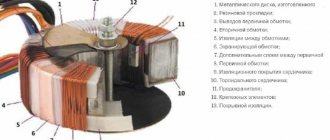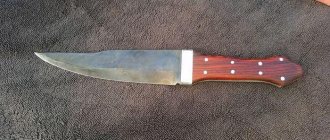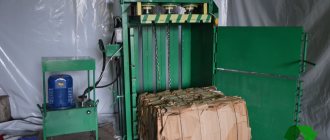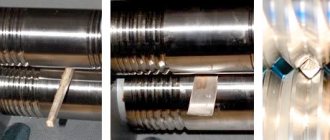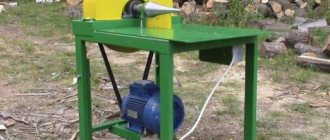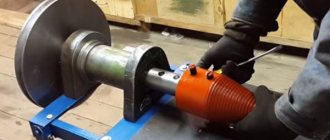Such a simple device as a soldering iron has its own design and component parts. The smallest in size, but not in importance, is the sting. The soldering iron’s ability to perform its tasks depends on its quality.
Working tip properties:
- Thermal conductivity. The most important characteristic. It is this that determines how much heat from the heater will be transferred to the work area;
- The ability to accumulate thermal energy. The characteristic is mainly related to the size of the sting. A tip that is too thin will instantly give off heat when it comes into contact with a massive part;
- Strength, or more precisely, wear resistance. No one is going to hammer nails with a soldering iron. However, over time, the tip wears out - under the influence of aggressive fluxes or mechanically;
- Protection from oxidation. Even the thinnest film of oxides sharply reduces the ability of the tip to transfer thermal energy to the soldering site.
The ideal material for the manufacture of a soldering tip (from the point of view of thermal conductivity) is copper or its alloys. The reverse side of the moon is extremely low wear resistance and susceptibility to corrosion.
The direct opposite is steel and nickel alloys. High strength, no corrosion - but disgusting thermal conductivity.
Therefore, manufacturers produce soldering iron tips from various materials, adapting to market demands. They also do not stop experimenting with composite materials, giving tools ever higher consumer properties.
Varieties of stings
All modern sets of tips for soldering irons differ significantly from each other, it all depends on the material, protective coating, shape and thickness. In addition, each replacement tool can dissipate different amounts of power, which is very important when choosing the most suitable product. Experts say that the most important thing to consider is what material the tip is made of and what shape it has.
As for the material, depending on the tasks, you can use tips with copper, ceramic, copper-steel, brass, chrome or nickel coating. The shape of the product can also differ significantly: curved, pointed, cone-shaped and even with a cut. As practice shows, it is easiest to use a curved device to remove excess solder, as well as to dismantle parts from the board. It is the material and shape of the tips that play an important role in the operation of the soldering iron, since the following characteristics depend on them:
- The resulting ability to inject energy at the soldering site. It is this characteristic that determines the possibility of high-quality and uniform heating of the working area.
- The level of thermal conductivity, which determines the final amount of heat supplied from the soldering tool to the working area.
- The degree of resistance of the tip used to oxidation.
A high-quality soldering iron with a replaceable tip must be equipped with a tip made of copper and special alloys. This criterion is due to the fact that the final thermal conductivity of the removable product will be significantly higher than that of steel parts.
But, despite all the advantages, even copper tips have their drawbacks. The main part of them is associated with the low level of wear resistance of the material and the fact that they are susceptible to the negative effects of corrosion. To eliminate these nuances, manufacturers apply a nickel or steel coating to the tip, and the thermal conductivity of the tip changes.
Due to the fact that gas soldering irons are widely in demand both in the private and industrial spheres, manufacturers produce a wide range of tips with different performance characteristics. Thanks to this, you can purchase the most suitable soldering iron rod at an affordable price.
Soldering stations
Those who need even more functions can purchase a soldering station. The LUKEY 936A soldering station is widely used among radio amateurs; I have one right next to my house.
Soldering station Lukey 936A
Using the regulator, you can set the tip temperature from 200 to 480 degrees. The soldering iron structure of this soldering station is shown in the diagram below:
Soldering iron soldering station design
The soldering iron of this station is powered by a voltage reduced by a transformer, from 24 Volts. The transformer provides galvanic isolation from the network. After turning on the station, the red LED on the front panel of the station lights up, which means heating to the temperature set using the regulator. As soon as the desired temperature is reached, the LED begins to flash.
Soldering iron from soldering station
The power of the soldering iron according to the passport is 60 watts. Although in my practice there was a case where the soldering iron from the soldering station was unable to warm up the lead from a large polygon when desoldering, then I took out my 65 Watt EPSN, purchased just for these purposes, and it easily coped with this job. Tips can be changed easily in 30-40 seconds, of course, on a cooled soldering iron.
Main advantages
Universal soldering iron tips are distinguished by their versatility and high quality, which is very important for repair work. The great demand for working tips is due to their many advantages:
- The ability to accumulate generated thermal energy. It is worth considering that this factor largely depends on the size of the part. Experts say that a soldering iron with a thin tip gives off all the heat at the first contact with the metal.
- High degree of thermal conductivity. This is one of the most important characteristics. This criterion determines how much heat from heating will be transferred to the main work area.
- Oxidation resistance. The presence of even the thinnest film of oxides several times reduces the ability of the tip to transfer heat to the soldering site.
- Good wear resistance. Of course, no one will use a soldering iron to perform tasks that are unusual for it, but over time, any tip wears out. This is mainly due to negative mechanical effects.
Due to numerous advantages, tips made of nickel alloys can be found in the collection of every master. This is due to the fact that such parts have a high level of strength and resist corrosion well. But the thermal conductivity in this case is at the lowest level.
Welding/sealing technology
Photo 6. What is needed to implement the technology of sealing/welding plastic film/bags: fiberboard substrate, metal ruler, PP film, roller soldering iron, stationery knife
- We do everything on a fairly heat-resistant substrate, you can take, for example, a piece of furniture-grade fiberboard plywood.
- We run the roller along a metal ruler (for evenness of the seam and uniform rolling speed of the roller) along the plastic films being welded.
- And then we put a ruler over the seam and run our finger along the ruler to compress and cool the seam rivets. (The division markings on a metal ruler are erased as you run your fingers over it while pressing, keep this in mind.)
- Using a stationery knife, cut off the excess/necessary.
USB Tool Parts
Many modern craftsmen are increasingly interested in how to make a thin tip for a USB soldering iron with an activator at home. It is worth considering that the tip must correspond to a value that is limited by the applied voltage. The best characteristics in this case are a thin tip made of high-quality materials.
If you have an old purchased product on hand , then you can use a spare tip, which is always included. Almost every craftsman who has minimal plumbing skills can make a tip for such a soldering iron on his own. In this case, it is better to give your preference to a copper rod, the diameter of which should not exceed three millimeters.
When the workpiece is cut to the required length, one of its ends should be sharpened. This procedure should be carried out depending on personal preferences, since it should be convenient for the master to solder the elements of the microcircuits. But the second end of the rod should be adjusted in thickness to the mounting hole in the soldering iron. Otherwise, you can apply a thread of the appropriate size.
Power cable or batteries?
Modern soldering irons for radio amateurs can be without a power cable at all. There are also models of soldering irons that operate from a computer port, the so-called USB soldering irons, and there are those that operate from separate batteries.
Here, who cares what is important: mobility or power, which largely depends on the power options for the soldering iron.
Planned sharpening of the soldering iron
In order for the tool to properly fulfill its main purpose, it must be periodically sharpened. The planned procedure involves the following points:
- To sharpen the tip, it is best to use a standard file, which should be held at an angle of 40˚.
- The edge must be left a little blunt, its width should be at least 1 mm.
- If the tip is completely new, then you can use fine sandpaper. These manipulations will help remove patina (a kind of copper oxide that has a characteristic green tint).
- If the craftsman is not satisfied with the factory method of sharpening, then you can remove the tip and forge it yourself, giving it the shape of a curved blade. This procedure has a huge advantage - after treatment, the metal is less susceptible to the negative effects of corrosion.
- If you need to give the tip a finished look, then you can process it with a regular file with a fine notch.
Selective
It cannot be said that the selective type of soldering is fundamentally different from capillary soldering. Solder and heat are used in the same way. But the solder is melted only in selected places (local points) to which the elements are planned to be attached.
Selective soldering is used mainly for the manufacture of circuit boards and pin components. It is similar to the wave method used for soldering SMD chips.
Selective soldering installation is equipment belonging to the semi-automatic category. It is not cheap, but it saves consumables almost ten times compared to the wave, so it is distributed wider and wider.
Optimal thickness
It is this criterion that is considered decisive in cases where the electric type of soldering iron is used to work with massive products. If you need to decide which soldering iron tip is best, then you need to familiarize yourself with their main varieties:
- Stinger-scapula. Widely used for soldering and desoldering large-sized radio components. The main physical purpose of this tip is to quickly and efficiently heat the entire surface of the part. During active work, the tip does not cool down, as it has a fairly large volume.
- An ordinary sting. A universal part with a wide range of applications. This tool was able to combine all the main advantages of stings, which is why it is considered one of the most popular.
- Sting-needle. This tip is less in demand among experienced craftsmen. The thing is that the moment it comes into contact with solder, it quickly cools down and ceases to perform its main function. Experts recommend using this tip for very small jewelry work.
- Curved tip type. Very convenient and practical for dismantling radio components and copper braiding, as well as for removing excess solder from the board. In addition, the tool is very practical for soldering.
- Sting-drop. Most often used by specialists to accurately transfer solder on a unique tip, which several times improves the quality of the work performed.
Capillary
Capillary type of soldering is the most common. Many people who use it are not even aware of this name. The essence of the technology is as follows.
The solder is melted, it heats up and fills the space between the two prepared parts. Wetting the surface of parts and retaining solder occurs largely due to the capillarity effect.
The capillary type of soldering is common in everyday life and in various industries. To do this you will need a soldering iron or torch. In fact, any type of soldering can be considered to a certain extent capillary, since in each there is capillary wetting of the workpiece surfaces with liquid solder.
Universal temperature stabilizers
Of course, quality material alone is not enough. It is necessary that the optimum temperature is maintained at the tip of the sting itself. It is for these purposes that a special sensor can be installed in his body. This option is considered optimal in situations where it is necessary to maintain a constant temperature in the soldering zone. These tools are especially important in cases where you need to work with elements that are sensitive to overheating. In this case, the technician can set the tip temperature to a higher temperature than the melting point of the solder.
A specialist can work without fear of damaging parts. In addition, most designs use fairly simple schemes when the temperature is set in advance and does not require constant monitoring. It is also worth considering that the regulator can be installed in a housing or placed in a separate unit. This does not affect the quality of work at all.
Today, there is a certain category of radio amateurs who most prefer their own tools, including tips for soldering irons. Most often, after trying many different options, the master chooses a specific tip or tries to make it himself.
Originally posted 2018-07-04 08:13:06.
Heating element types
Any soldering iron, no matter how expensive it is, performs soldering by melting the solder; soldering irons differ only in the heating method, heating elements, the presence of temperature control and other parameters. The following is a table with types of heaters.
| Heater type | Active element | Heat loss | Advantages | Flaws | Approximate heating time |
| Nichrome | Nichrome wire | High | Simplicity | Nichrome burnout | high inertia |
| Ceramic | Nichrome wire in sintered ceramic | Low | Durable | fragile | Tens of seconds |
| Induction | Ferrite | Low | Durable | Temperature adjustable | Seconds |
High heat loss means that not all of the expended energy was transferred to the tip; the higher the heat loss, the worse the temperature control.
The most common are nichrome heaters and their varieties, due to their ease of maintenance, low price and simple operation.
Next in popularity are ceramic ones; their heating element is distributed evenly throughout the heater, resulting in high heat transfer and minimal losses.
The top three are inductive heaters; they operate on the principle of an inductive electric stove - the metal is heated due to magnetic induction, but at a certain temperature (Curie point), the heating stops and a constant temperature is maintained. It should be noted that the operating temperature is determined by the material of the tip.
Power Features
Power is a key physical and technical parameter. It determines how efficiently and quickly the equipment will cope with a specific task. There are four power classes in total:
- Low-power models
- up to 20 watts (W). As a rule, the minimum value is 3 W. This is enough for the simplest microcircuits, the smallest parts, very thin wires, etc. - Medium-power models
- from 20 to 60 W. Most often, models are produced in the range of 20-40 W. Suitable for most radio components, household wires, lamps, microcircuits. - High power models
- from 60 to 100 W. These are models for universal use. They can handle most household tasks, including repairing plastic and metal products. - Production models
- more than 100 W. For domestic use it is redundant. This level is needed to work with very thick wires or thick sheets of metal.
For most types of soldering that can be done at home, it is better to choose soldering irons with a power of 20 to 60 W. This is quite enough for working with radio components, microcircuits, wires, lamps and other similar things. Larger values will only be needed for soldering metal utensils. But objectively, its modern examples are not intended for handicraft repairs.
Fluxes: basis for soldering in radio electronics
As a rule, a radio amateur has many different chemicals in his arsenal, which allows him to create the highest quality and reliable solder.
Fluxes are special chemicals intended for radio installation. It allows you to remove oxide films and allows the solder to spread evenly. Fluxes are divided into several types: neutral, active and anti-corrosion.
5.1. Neutral fluxes
Neutral are the most popular, simple and safe fluxes. They do not contain acids or other aggressive elements that cause corrosion of metals, and generally do not require rinsing.
Rosin, the cheapest type of flux, is a must-have for every radio amateur. It protects the surface from oxides and prevents corrosion. We can say that this is a universal type of flux.
LTI 120 is a liquid flux, classified as neutral. It contains no acids, which means it will not corrode metal. The basis of its composition is rosin dissolved in alcohol. LTI-120 is easy to use: you just need to apply a layer of flux to the surface to be soldered, and then solder the desired element to the board.
On sale you can also find gel fluxes based on rosin. They are very convenient for soldering when you only need to apply a small amount of flux to a specific area. Flux-Plus is the most common type of flux on the radio market.
Its cost is quite high - about 500 rubles , but to be honest, it fully justifies its price. If you repair cell phones and other microelectronics, then it will be indispensable in your work.
Typically, neutral fluxes do not require rinsing, however, many hams prefer to rinse off any flux after use.
5.2. Active fluxes
Active (also called acid) fluxes contain hydrochloric, phosphoric or citric acid. After using them, it is necessary to wash the part, since flux residues will cause corrosion and corrode the soldering. These fluxes mainly remove aggressive substances from soldered parts.
The most popular flux of this type is soldering acid. It can be used to solder, for example, nickel alloys.
F38N is used for soldering resistant corrosion steel, various copper alloys, bronze, nichrome and brass. Residues of F38N can be easily washed off with water.
5.3. Other types
There are also anti-corrosion fluxes consisting of phosphoric acid. They do not cause corrosion of ferrous metals, which means there is no need to remove flux residues after soldering.
For non-ferrous metals, rinsing with warm water is recommended. In addition to water, fluxes can be washed off with acetone, nephrase, ethyl or isopropyl alcohol. All of these products are suitable for cleaning printed circuit boards.
There are also solder pastes, which are a mixture of flux and solder. It happens that such pasta is made independently. You just need to use a file to make shavings from solder and mix it with liquid fluxes.
This paste can be applied to the part and then warmed up the soldering iron. It can be used when soldering surface-mounted installations or used in hard-to-reach places on the board.
Final Recommendations
So, which soldering iron option is the best choice for the home? It depends on what exactly you plan to solder with it. For microcircuits, small radio components and printed circuit boards, pulsed or spiral devices with a power of up to 30 W are suitable. For soldering wires, large radio components, repairing lamps and most home electrical work, it is more convenient to use different types of electrical rods with an average power of about 60 W. Equipment at the level of 100 W or more will be required to repair metal products. And in general, it is better to buy a good electric rather than a gas model, rod (straight) or pistol design.

